Setting IP Addresses
| Article ID: ART165235 | | | Date published: 04/01/2016 | | | Date last updated: 09/12/2017 |
Description
Setting IP Addresses
Solution
| Solution |
Connecting the machine to a network requires a unique network IP address. Two versions of IP addresses are available: IPv4 and IPv6. Configure these settings depending on the network environment. To use IPv6 addresses, you need to properly configure the IPv4 address settings.
Setting IPv4 Address The machine's IPv4 address can be either assigned automatically by a dynamic IP addressing protocol, such as DHCP, or entered manually. When connecting the machine to a wired LAN, make sure that the connectors of the LAN cable are firmly inserted into the ports [ Basic Network Settings ]. You can test the network connection if necessary.
1. Tap <Menu> in the Home screen
2. Tap <Network Settings>.
3. Select <TCP/IP Settings>


 <IPv4 Settings> <IPv4 Settings>

 <IP Address Settings>. <IP Address Settings>.
4. Configure IP address settings.
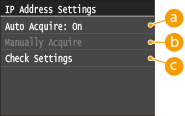
 <Auto Acquire> <Auto Acquire>Select to automatically assign an IP address via DHCP protocol. When <Auto Acquire: On> is displayed, automatic addressing is enabled.
 <Manually Acquire> <Manually Acquire>Select to configure the IP address settings by manually entering an IP address. In order to select this option, <Auto Acquire> must be set to <Off>.
 <Check Settings> <Check Settings>Select when you want to view the current IP address settings.
 4-A. Automatically assigning an IP address 4-A. Automatically assigning an IP address
4-A-1. Select <Auto Acquire>


 <Select Protocol>. <Select Protocol>.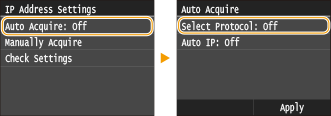
4-A-2. Tap <DHCP>.
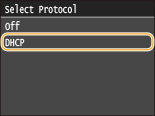

If you do not want to use DHCP to assign an IP address
4-A-3. Check that <Auto IP> is set to <On>.
4-A-4. Tap <Apply>.

 4-B. Manually entering an IP address 4-B. Manually entering an IP address
4-B-1. Check that <Auto Acquire> is set to <Off>.
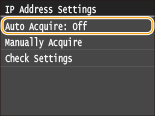
4-B-2. Tap <Manually Acquire>.
4-B-3. Specify the IP address, subnet mask, and gateway address (or default gateway).

5. Restart the machine.
 Testing the Network Connection Testing the Network Connection
1. Tap <Menu> in the Home screen.
2. Tap <Network Settings>.
3. Select <TCP/IP Settings>


 <IPv4 Settings> <IPv4 Settings>

 <PING Command>. <PING Command>.
4. Enter the IPv4 address of another device on the network, and tap <Apply>.
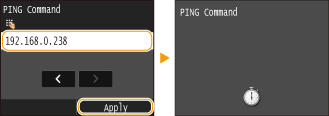
 If a proper connection has been established, the following screen is displayed. If a proper connection has been established, the following screen is displayed.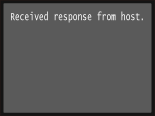
Setting IPv6 Addresses The IPv6 addresses of the machine can be configured via the Remote UI. Before setting IPv6 addresses, check the IPv4 address settings. You need to set the correct IPv4 settings to use IPv6 addresses. Note that the scan function that uses the scanner driver or MF Scan Utility is not available in an IPv6 environment. The machine can use up to nine of the following IPv6 addresses:
1. Start the Remote UI and log on in System Manager Mode.
2. Click [Settings/Registration].
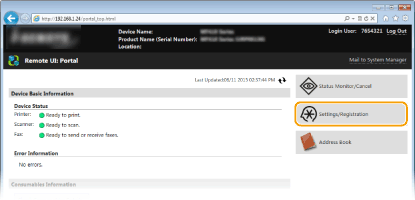
3. Click [Network Settings]


 [TCP/IP Settings]. [TCP/IP Settings].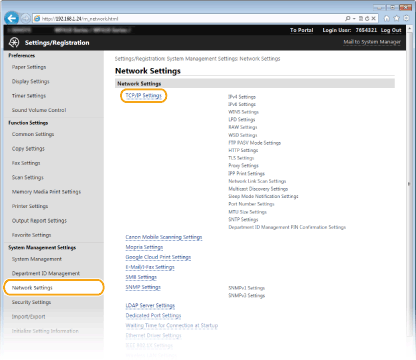
4. Click [Edit] in [IPv6 Settings].
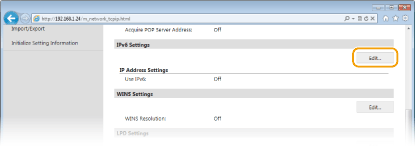
5. Select the [Use IPv6] check box and configure the required settings.
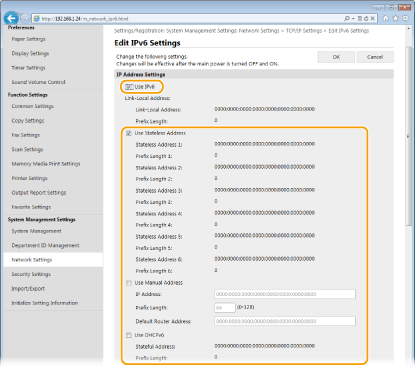
[Use IPv6]
Select the check box to enable IPv6 on the machine. When not using IPv6, clear the check box.
[Use Stateless Address]
Select the check box when using a stateless address. When not using a stateless address, clear the check box.
[Use Manual Address]
When you want to manually enter an IPv6 address, select the check box and enter the IP address, prefix length, and default router address in the corresponding text boxes.
[IP Address]
Enter an IPv6 address. Addresses that start with "ff" (or multicast address) cannot be entered.
[Prefix Length]
Enter a number that indicates how many bits are available for the network address.
[Default Router Address]
Specify the IPv6 address of the default router as necessary. Addresses that start with "ff" (or multicast address) cannot be entered.
[Use DHCPv6]
Select the check box when using a stateful address. When not using DHCPv6, clear the check box.
6. Click [OK].
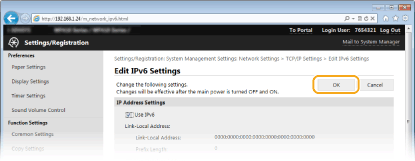
7. Restart the machine.
Viewing Network Settings
 Viewing IPv4 Settings Viewing IPv4 Settings


 <Network Information> <Network Information>

 <IPv4> <IPv4>

 Select the setting to view Select the setting to view

 Check the settings Check the settings



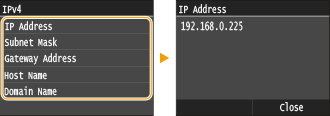
 Viewing IPv6 Settings Viewing IPv6 Settings


 <Network Information> <Network Information>

 <IPv6> <IPv6>

 Select the setting to view Select the setting to view

 Check the settings Check the settings 



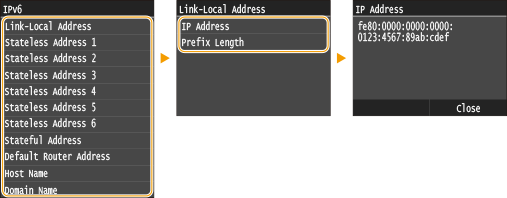
 Viewing the MAC Address for Wired LAN Viewing the MAC Address for Wired LAN
1. Tap <Menu> in the Home screen.
2. Tap <Network Settings>.
3. Tap <Ethernet Driver Settings>.
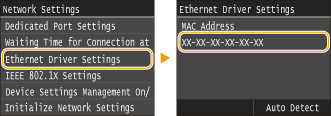
 Viewing the MAC Address and Information for Wireless LAN Viewing the MAC Address and Information for Wireless LAN
1. Tap <Menu> in the Home screen.
2. Tap <Network Settings>.
3. Tap <Wireless LAN Settings>.
4. Read the message that is displayed, and tap <OK>.
5. Tap <Connection Information>.
6. Select the setting to view.
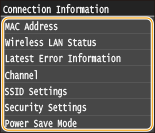
 Viewing WEP and WPA/WPA2-PSK information Viewing WEP and WPA/WPA2-PSK information
1. Tap <Security Settings>.
2. Confirm and tap the current security setting.
3. Select the setting to view.
WEP
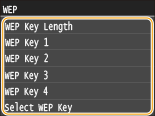
WPA/WPA2-PSK
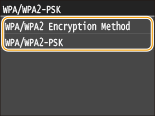

|
|||||||||||||||
| Related Info |
Basic Network Settings
|
|||||||||||||||
|
ID: 8202777600_EN_1
|
||||||||||||||||
SIMS Doc Id
8202777600

 . For details, see the "e-Manual" (HTML manual) in the DVD-ROM supplied with the machine.
. For details, see the "e-Manual" (HTML manual) in the DVD-ROM supplied with the machine.